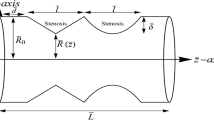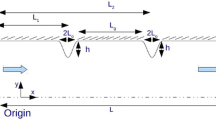Abstract
Pulsatile flow of a two-phase model for blood flow through arterial stenosis is analyzed through a mathematical analysis. The effects of pulsatility, stenosis, peripheral layer and non-Newtonian behavior of blood, assuming the blood in the core region as a Herschel-Bulkley fluid and the plasma in the peripheral layer as a Newtonian fluid, are discussed. A perturbation method is used to solve the resulting system of non-linear quasi-steady differential equations. The expressions for velocity, wall shear stress, plug core radius, flow rate and resistance to flow are obtained. It is noticed that the plug core radius and resistance to flow increase as the stenosis size increases while all other parameters held constant The wall shear stress increases with the increase of yield stress while keeping other parameters as invariables. It is observed that the velocity increases with the axial distance in the stenosed region of the tube upto the maximum projection of the stenosis.
Similar content being viewed by others
References
Bakirtas, I., Antar, N., 2003, “Evolution Equations for Nonlinear Waves in a Tapered Elastic Tube Filled with a Viscous Fluid,”International Journal of Engineering. Science, Vol. 41, pp. 1163–1176.
Bugliarello, G., Sevilla, J., 1970, “Velocity Distribution and Other Characteristics of Steady and Pulsatile Blood Flow in Fine Glass Tubes,”Biorheology, Vol. 7, pp. 85–107.
Chakravarthy, S., Mandai, P. K., 2000, “Two-Dimensional Blood Flow Through Tapered Arteries Under Stenotic Conditions,”International Journal of Non-Linear Mechanics, Vol. 35, pp. 779–793.
Chaturani, P., Ponnalagar Samy, R., 1985, “A Study of Non-Newtonian Aspects of Blood Flow Through Stenosed Arteries and its Applications in Arterial Diseases,”Biorheology, Vol. 22, pp. 521–531.
Chaturani, P., Ponnalagar, Samy, R., 1986, “Pulsatile Flow of Casson’s Fluid Through Stenosed Arteries with Applications to Blood Flow,”Biorheology, Vol. pp. 23, 499–511.
Chiu, J. J., Wang, D. L., Chien, S., Skalak, R., Usami, S., 1998, “Effects of Disturbed Flow on Endothelial Cells,”ASME Journal of Biomechanical Engineering, Vol. 120, pp. 2–8.
Cokelet, G. R., 1972, The Rheology of Human Blood, In: Fung, Y. C. (Eds),Biomechanics, Prentice-Hall, Englewood Cliffs, N. J., pp. 63–103.
Dash, R. K., Jayaraman, G., Metha, K. N., 1999, “Flow in a Catheterized Curved Artery with Mild Stenosis,”Journal of Biomechanics, Vol. 32, pp. 49–61.
Iida, N., 1978, “Influence of Plasma Layer on Steady Blood Flow in Micro Vessels,”Japanese Journal of Applied Physics, Vol. 17, pp. 203–214.
Kapur, J. N., 1992,Mathematical Models and Mothods in Biology and Medicine, Affiliated East-West Press Pvt. Ltd, New Delhi.
Karino, T., Goldsmith, H. L., 1977, “Flow Behavior of Blood Cells and Rigid Spheres in Annular Vortex,”Philosophical Transactions of the Royal Society, Vol. B279, pp. 413–445.
Liepsch, D., Singh, M., Martin, L., 1992, “Experimental Analysis of the Influence of Stenotic Geometry on Steady Flow,”Biorheology, Vol. 29, pp. 419–431.
Liu, G. T., Wang, X. J., Ai, B. Q., Liu, L. G., 2004, “Numerical Study of Pulsating Flow Through a Tapered Artery with Stenosis,”Chinese Journal of Physics, Vol. 42, pp. 401–409.
Long, Q., Ku, X. Y., Ramnarine, K. V., Hoskins, P., 2001, “Numerical Investigations of Physiologically Realistic Pulsatile Flow Through Arterial Stenosis,”Journal of Biomechanics, Vol. 34, pp. 1229–1242.
Mandai, P. K., 2005, “An Unsteady Analysis of Non-Newtonian Blood Flow Through Tapered Arteries with a Stenosis,”International Journal of Non-Linear Mechanics, Vol. 40, pp. 151–164.
Marshall, I., Zhao, S., Papathanasopoulou, P., Hoskins, P., Xu, X. Y., 2004, “MRI and CFD Studies of Pulsatile Flow in Healthy and Stenosed Carotid Bifurcation Models,”Journal of Biomechanics, Vol. 37, pp. 679–687.
Merrill, E. W., 1969, “Rheology of Blood,”Physiological Reviews, Vol. 49, pp. 863–888.
Moayeri, M. S., Zendehbudi, G. R., 2003, “Effects of Elastic Property of the Wall on Flow Characteristics teristics Through Arterial Stenosis,”Journal of Biomechanics, Vol. 36, pp. 525–535.
Pralhad, R. N., Schultz, D. H., 1988, “Two-Layered Blood Flow Through Stenosed Tubes for Different Diseases,”Biorheology, Vol. 25, pp. 715–726.
Sankar, D. S., Hemalatha, K., 2006, “Pulsatile Flow of Herschel-Bulkey Fluid Through Stenosed Arteries-A Mathematical Model,”International Journal of Non-Linear Mechanics, Vol. 41, pp. 979–990.
Segers, P., Verdonck, P., 2000, “Role of Tapering in Arotic Wave Reflection: Hydraulic and Mathematical Model,”Journal of Biomechanics, Vol. 33, pp. 299–306.
Shukla, J. B., Parihar, R. S., Gupta, S. P., 1980a, “Effects of Peripheral Layer Viscosity on Blood Flow Through the Artery with Mild Stenosis,”Bulletin of Mathematical Biology, Vol. 42, pp. 797–805.
Shukla, J. B., Parihar, R. S., Rao, B. R. P., 1980b, “Effects of Stenosis on Non-Newtonian Flow of the Blood in an Artery,”Bulletin of Mathematical Biology, Vol. 42, pp. 283–294.
Srivastava, V. P., Saxena, M., 1994, “Two-Layered Model of Casson Fluid Flow Through Stenotic Blood Vessels: Applications to the Cardiovascular System,”Journal of Biomechanics, Vol. 27, pp. 921–928.
Srivastava, V. P., 1996, “Two-Phase Model of Blood Flow Through Stenosed Tubes in the Presence of a Peripheral Layer: Applications,”Journal of Biomechanics, Vol. 29, pp. 1377–1382.
Tu, C., Deville, M., 1996, “Pulsatile Flow of Non-Newtonian Fluids Through Arterial Stenosis”Journal of Biomechanics, Vol. 29, pp. 899–908.
Author information
Authors and Affiliations
Corresponding author
Additional information
Currently on leave from Department of Mathematics, Crescent Engineering College Vandalur, Chennai-600 048, Tamil Nadu, India.
Rights and permissions
About this article
Cite this article
Sankar, D.S., Lee, U. Two-phase non-linear model for the flow through stenosed blood vessels. J Mech Sci Technol 21, 678–689 (2007). https://doi.org/10.1007/BF03026973
Received:
Revised:
Accepted:
Issue Date:
DOI: https://doi.org/10.1007/BF03026973




